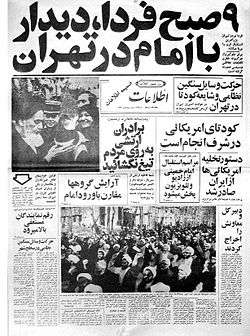Fajr decade
Part of a series on the |
|---|
| History of the Iranian Revolution |
 |
|
Revolutionary leaders
|
|
Official institutions |
|
See also |
Dahe-ye Fajr (Persian: دهه فجر, lit. 'ten days of dawn'),[1][2] i.e. dawning of new age, is a ten-day celebration of Ruhollah Khomeini's return to Iran in 1979.[2][3] The annual celebrations last from 1 to 11 February.[4] The start of the celebration coincides with the date of Ruhollah Khomeini's arrival and the ending with Revolution's victory, a day which is called Islamic Revolution's Victory Day or 22 of Bahman.[3][5]
The ten days

Dahe-ye Fajr marks the anniversary of the ten days from Khomeini's return to Iran (1 February) until the victory day of the Revolution (22 Bahman; 11 February) in 1979.[3]
1 February
On the first of February 1979, Ayatollah Khomeini returned to Tehran after a period of being exiled by Muhammad Reza Pahlavi to France. Several million people went to the Mehrabad International Airport for welcoming Ayatollah Khomeini.[6] Khomeini, then went to Behesht-e Zahra cemetery where he gave a lecture. Khomeini expressed that Shapour Bakhtiar's cabinet was illegal. Also, he said he would crash in the mouth of the Bakhtiar's government.[7][8]
5 February
Ayatollah Khomeini choose Mehdi Bazargan as prime minister of interim government.[7]
8 February
Iran air force officers went to Khomeini's home and promised their loyalty to the revolution.[9]
10 February
People were armed by the revolutionary personnel of the air force. In this day a curfew was announced by Bakhtiar's government but Ruhollah Khomeini disparaged it and said people had to break it. Then revolutionaries subjugated police stations, prisons and governmental centers.[10]
11 February
Senior military commanders announced that they were neutral in conflict between Bakhtiar's government and revolutionaries. Thus they receded from the streets.[9] Bakhtiar resigned and went to Paris. Revolutionaries gained a victory in this day.[11]
Customs
Dahe-ye Fajr is celebrated in various ways, including commemorations at Khomeini's mausoleum and rallies for the achievements of the revolution.[12] The Fajr International Film Festival has been held every year since 1982 in Tehran during Dahe-ye Fajr. It is organised by the Ministry of Culture and Islamic Guidance. It is the largest public film, theater, and music festival in Iran.[13]
See also
References
- ↑ Burke, Andrew; Elliott, Mark (2008). Iran. Lonely Planet. p. 382. ISBN 978-1-74220-349-2. Retrieved 12 February 2016.
- 1 2 Azam Torab (2007). Performing Islam: Gender and Ritual in Islam. BRILL. p. 143,252. ISBN 90-04-15295-4.
- 1 2 3 Lloyd Ridgeon; Lloyd V. J. Ridgeon (24 December 2012). Shi'i Islam and Identity: Religion, Politics and Change in the Global Muslim Community. I.B.Tauris. p. 78. ISBN 978-1-84885-649-3.
- ↑ Houshang Asadi (1 June 2010). Letters to My Torturer: Love, Revolution, and Imprisonment in Iran. Oneworld Publications. p. 235. ISBN 978-1-78074-031-7.
- ↑ Keiko Sakurai; Fariba Adelkhah (7 March 2011). The Moral Economy of the Madrasa: Islam and Education Today. Routledge. p. 103. ISBN 978-1-136-89400-8.
- ↑ Keshavarz, Kourosh (2009). Mirror from Stone.
- 1 2 Iran Country Study Guide Volume 1 Strategic Information and Developments. Lulu.com. 2012. p. 65. ISBN 9781438774626.
- ↑ Heather Lehr Wagner (2010). The Iranian Revolution. Infobase Publishing. p. 13. ISBN 978-1-4381-3236-5.
- 1 2 Int'l Business Publications (2005). Iran: Country Study Guide. p. 124.
- ↑ Hosseini, Mir Masood. "Bakhtiar Becomes Prime Minister". fouman.
- ↑ "1979: Victory for Khomeini as army steps aside". bbc.
- ↑ Coughlin, Con (9 February 2010). "Endgame for Mahmoud Ahmadinejad in Iran?". The Telegraph.
- ↑ Ian Hayden, Smith (2012). International Film Guide 2012. p. 146. ISBN 978-1908215017.